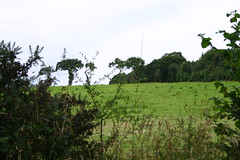 |
| Jeroen leading a mix of the 82nd and 101st Airborne to a clear victory |
Jeroen came to the club to have another playtest session yesterday. We used the version 0.3 rules, with the new close combat rules, which we gave a bit of a testing. General flow of the game went very well, apart from some "where did I put that part of the rules" moments. I clearly need an index. Also, some of the rules have been developed - mostly in calc because I have access to statistic functions there - but have not yet made it into the rulebook. Some of those I found in my little black notebook, but it all caused a significant loss of time. The QR sheet was a big improvement, but I have to make sure everything relevant is on there. The huge gameturn sequence was over the top, and it does not improve game flow awareness. From all of this you'd gather the game went down the drain, but it actually went well, the general feel is becoming very tactical, choices really matter, it's not just roll better than the opponent.
Corrections and additions to the rules:
The to Hit table has no area type target, which we need for smoke
Area type target is not suited for concealed target, as it actually increases the hit chance.
ROF revision, enter it in the manual (UNITS) and QR sheet.
Infantry can only throw smoke as far as 1"
PF PSK Baz Ranges and TK# in manual and QR sheet.
Turn Sheet with wind indicator and weather effects overview.
Malfunction markers for main gun
Road yields movement bonus for vehicles, tanks only if CE
Generate indexes for the next version, the manual is becoming too big to do without.
Plans for the near future:
Make more bocage so we can try another type of scenario with an elevated road
Paint up utility vehicles, a few more tanks, and some US regular and German 6th paras
Design the scenario sheets for two types of scenario's, the village outskirts and bocage attack.






